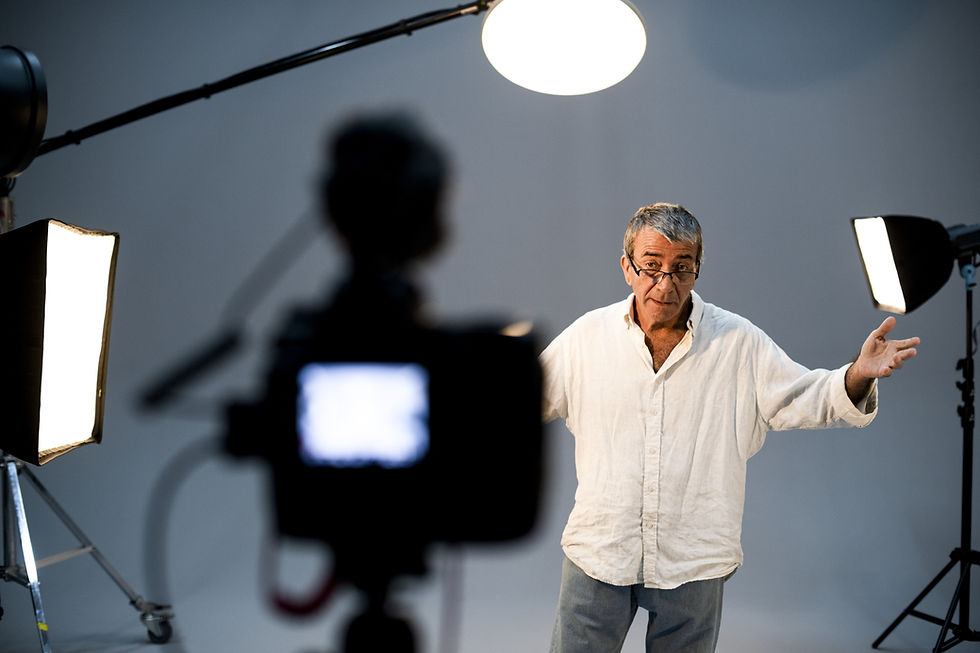
In the ever-evolving acting landscape, self-taped auditions have become a ubiquitous tool for performers to showcase their talent. With the rise of technology and the convenience of recording from home, actors now have the opportunity to submit audition tapes without ever setting foot in a casting office. However, amidst this convenience, a crucial aspect often gets overlooked but can significantly impact the success of a self-taped audition: headroom.
Headroom refers to the space between the top of an actor's head and the edge of the frame in a video recording. It might seem like a minor detail, but the amount of headroom in a self-taped audition can make a substantial difference in how the performance is perceived by casting directors and industry professionals. Let's delve into why tight framing matters and how it can elevate the quality of your self-taped auditions.
Creating a Professional Impression
First impressions matter, especially in the competitive world of acting. When a casting director views your self-taped audition, they want a professional presentation demonstrating your commitment to your craft. One way to convey this professionalism is through the framing of your video.
A tight frame that eliminates excessive headroom looks more polished and demonstrates attention to detail. It shows that you understand the technical aspects of self-taped auditions and are willing to put in the effort to present yourself in the best possible light. Casting directors are more likely to take notice of actors who present themselves professionally, and tight framing is an essential component of that presentation.
Fostering Connection with the Audience
Acting is a visual medium; every aspect of your performance contributes to the audience's perception of your character. The framing of your self-taped audition can influence how the audience connects with your performance emotionally.
Excessive headroom can create a sense of detachment between the actor and the viewer. It leaves empty space above the actor's head, which can be distracting and detract from the intimacy of the performance. Tight framing, on the other hand, allows the audience to focus squarely on the actor's face and expressions, fostering a deeper connection and enhancing the impact of the performance.
Highlighting Facial Expressions and Emotions
One of the most powerful tools in an actor's arsenal is their ability to convey emotions through facial expressions. In a self-taped audition, your face is your most valuable asset, and tight framing ensures it remains front and center throughout the recording.
By minimizing headroom, you maximize the screen real estate dedicated to your face, allowing casting directors to see every nuance of your expressions. Whether it's a subtle smirk or a heartfelt tear, tight framing ensures that your emotions are conveyed with clarity and intensity. This level of detail can make all the difference in how casting directors perceive and remember your performance.
Maintaining Focus and Engagement
In addition to showcasing your facial expressions, tight framing helps maintain focus and engagement throughout your self-taped audition. With minimal headroom, fewer distractions pull the viewer's attention away from the actor's performance.
A well-composed frame guides the viewer's eyes directly to the actor's face, keeping them engaged with the performance from start to finish. This is particularly important in self-taped auditions, where casting directors may be reviewing numerous submissions in a short amount of time. By maintaining focus and engagement, tight framing increases the likelihood that your audition will leave a lasting impression.
Tips for Achieving the Perfect Frame
Now that we understand why tight framing matters in self-taped auditions, let's explore some practical tips for achieving the perfect frame:
Use a tripod: Investing in a sturdy tripod is essential for maintaining a steady and consistent frame throughout your audition.
Position the camera at eye level: Ensure that the camera is positioned at eye level to capture the most flattering angle of your face.
Frame the shot appropriately: Leave a small amount of space above your head to avoid a cramped frame, but be mindful of minimizing excessive headroom.
Check your framing before recording: Take the time to review the framing of your shot before recording to ensure that it meets your desired specifications.
Consider the context of the scene: Adjust your framing based on the emotional tone and context of the scene you are performing.
By following these tips and paying attention to the framing of your self-taped auditions, you can enhance the professionalism, emotional impact, and overall quality of your performances. Remember, every detail counts when making a lasting impression on casting directors and industry professionals.
In the competitive world of acting, every opportunity to showcase your talent counts. Self-taped auditions offer actors the chance to audition for roles from anywhere in the world, but their success hinges on various factors, including the framing of the video.
Tight framing might seem like a minor detail, but its impact on the perception and effectiveness of a self-taped audition must be balanced. By minimizing headroom and creating a polished, engaging frame, actors can enhance their professionalism, foster a deeper connection with the audience, and elevate the quality of their performances.
So, the next time you're preparing for a self-taped audition, remember the importance of tight framing and its role in making a memorable impression. Your attention to detail could be the difference between landing the role of a lifetime and blending into the background.

Looking for professional audition taping and coaching? If you're an actor or VO artist and are in the Louisville, Kentucky region - visit Everything Cinema Productions for first-rate taping services!



Thanks.